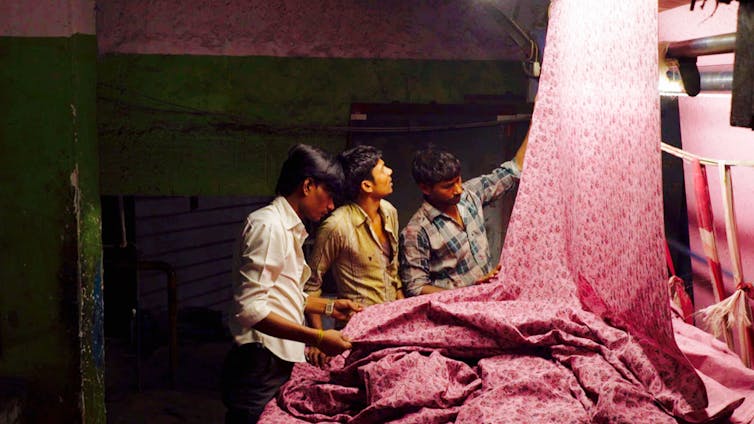I have spent the last decade researching the global textile and garment industries and the harshness of the sweatshop regime they shape for millions of workers worldwide. While researching my book, I followed the clothing production line across the whole Indian subcontinent. I met a very diverse army of labourers: male migrants endlessly circulating between factories and villages; young women commuting daily to the factory gates; children and youths facing a life of toil in home-based workshops.
Despite their diversity, India’s garment workers share a similar fate. All trapped inside the sweatshop regime, their own bodies are turned into commodities – yet another crucial input of production, like threads and cloth.
One image above all captures the working poverty of sweatshops for me: Amelia Peláez’s painting La Costurera, which can be admired at the Malba museum in Buenos Aires. It is a simple sketch of a woman in the act of stitching. Crucially, the bundle of cloth she is using is her own body. In the act of toiling, she is also “manufacturing” herself into a worker. Peláez powerfully reminds us what is at the very centre of production: the body, which, as the feminist Silvia Federici reminds us, is the first ever machine invented by capitalism.
Indeed, in labour-intensive manufacturing industries such as those of textiles and garments, the body is the first machine used, and also the first machine depleted, and relentlessly so, by the process of production. This is why I enjoyed watching the new documentary by Rahul Jain so much. Machines is set in a textile factory in Surat, Gujarat, India. In Jain’s vision of the textile factory, the body takes centre stage.
Workers’ bodies ––always on the move like well-behaved, docile bees building their hive – are the heart, soul and sound of Jain’s factory. They create the soundtrack of labouring, which merges with the steady rhythmic pace of the machines, and that of cloth endlessly pouring from the press.
Jain perfectly captures the image and tone of labour-intensity with close-ups of exhausted workers subjected to thankless 12-hour shifts. We often see them struggling to remain awake. They are all male migrants – no women feature in the documentary – who need to leave their villages and farms to survive. Our own last project report on the garment industry completed last year indicates that 12- to 16-hour shifts are the norm in the sector for this type of worker.

Relentless harassment
There are many misunderstandings about poverty. People are not poor because they are excluded from the processes of production. They are poor because of the ways in which production absorbs them, literally sucking their labour out of their limbs. The poor cannot afford to sit idle. As one worker interviewed by Jain puts it: “poverty is harassment”. Poor working conditions – long working shifts, sleep deprivation, exposure to toxic substances, cloth particles and smoke, matched with meagre and discontinuous salaries (all touched upon in this documentary) – constantly harass the poor inside the factory.
And this constant harassment that accompanies working poverty is often enabled by violence. Unions are powerless because employers are swift in targeting union leaders. The unions are often quickly retrenched. Eventually, workers may also be exposed to physical violence. Undoubtedly, India’s textile industry has a long history of violence against trade unionists. In 1997, over ten years after heading Bombay’s legendary textile mills strike, Dutta Samant, the workers’ leader, was gunned down by contract killers outside his house.

If unions have little power over workers, who are too scared and poor to fight for their rights, labour contractors are their undisputed masters. They not only have the power to choose the workers’ destiny by brokering their labour from villages to textile factories, but they are also the workers’ lenders of last resort, providing advances in cash.
The contractor interviewed by Jain for Machines knows this all too well. He knows he is the workers’ real boss. On the other hand, workers have no idea who owns the factory – who the “actual” boss is. In the words of another worker interviewed by Jain: “I don’t even know who the boss is, what he does (…) I know my section, I know my room, that’s it.”
Much of the textile and garment industry in India is characterised by such “triangular labour relations”, where intermediaries interrupt any relationship between workers and factory owners.
Industrial violence
In the age of global capitalism and the attendant questions of labour conditions and rights, we can learn an awful lot from this documentary. A particular issue is that current debates are often framed around ideas of modern-day slavery. This language is misleading. It suggests extreme forms of exploitation may be something new and exceptional. This is hardly the case.
First, the intensity of exploitation experienced by workers is nothing new, in India’s textile factories or elsewhere. Workers’ harsh subjugation to the rhythms of production is timeless. The violence they endured has crossed space, time and generations, from the early development of Britain’s “dark satanic mills”. For instance, in Jain’s factory, the presence of child labour is not a one-off violation of labour regulations. Rather, growing up in the factory is part and parcel of the workers’ industrial life.

Second, this type of exploitation is hardly exceptional. After the fourth anniversary of the Rana Plaza tragedy, we should remind ourselves once more how this terrible disaster was not the outcome of exceptional circumstances. It was driven by the normal pace of an industry systematically unable to guarantee decent working conditions for its workforce. Exhaustion, as well as the constant, inexorable depletion of the labouring body, is a fundamental aspect of factory life for millions of working poor worldwide, even in the absence of major industrial disasters.
Rahul Jain’s Machines shows us the restless movements leading to that process of exhaustion; their repetitive sounds, dark colours, and the fading hopes of India’s proletariat.

